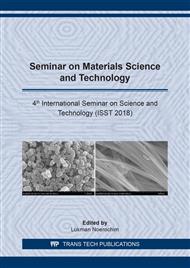[1]
D. Ellis, The effect of titanium inclusions on HY-80 GMA weld deposits, Naval Postgraduate School, Monterey, California, (1990).
Google Scholar
[2]
K. Sampath, Constraints-based modeling enables successful development of a welding electrode specification for critical Navy applications, Welding Journal, (2005).
Google Scholar
[3]
P. Yayla, E. Kaluc, K. Ural, Effects of welding processes on the mechanical properties of HY80 steel weldments, Materials and Design 28: 1898-1906, (2007).
DOI: 10.1016/j.matdes.2006.03.028
Google Scholar
[4]
G.A. Patella, A review of welding processes, mechanical properties, and weldability of HY80 castings, Rensselaer Polytechnic Institute, Hartford, CT, (2014).
Google Scholar
[5]
S. Kumar, S.K. Nath, Effect of heat input on impact toughness in transition temperature region of weld CGHAZ of HY85 steel, Journal of Materials Processing Technology 236: 216-224, (2016).
DOI: 10.1016/j.jmatprotec.2016.05.018
Google Scholar
[6]
K. Prasad, D.K. Dwivedi, Some investigations on microstructure and mechanical properties of submerged arc welded HSLA steel joints, Int J Adv Manuf Technol 36: 475-483, (2008).
DOI: 10.1007/s00170-006-0855-1
Google Scholar
[7]
R. Pamnani, T. Jayakumar, M. Vasudevan, T. Sakthivel, Investigations on the impact toughness of HSLA steel arc welded joints, Journal of Manufacturing Processes 21: 75-86, (2016).
DOI: 10.1016/j.jmapro.2015.11.007
Google Scholar
[8]
S. Ragu Nathan, V. Balasubramanian, S. Malarvizhi, A.G. Rao, Effect of welding processes on mechanical and microstructural characteristics of high strength low alloy naval grade steel joints, Defence Technology 11: 308-317, (2015).
DOI: 10.1016/j.dt.2015.06.001
Google Scholar
[9]
M. Pirninen, The effects of welding heat input on the usability of high strength steels in welded structures, Lappeenranta University of Technology, Lappeenranta, Finland, (2013).
DOI: 10.18057/icass2018.p.141
Google Scholar
[10]
R. Cao, J. Li, D.S Liu, J.Y. Ma, J.H. Chen, Micromechanism of decrease of impact toughness in the coarse-grain heat-affected zone of HSLA steel with increasing welding heat input, Metallurgical and Materials Transactions A, Vol. 46A: 2999-3014, (2015).
DOI: 10.1007/s11661-015-2916-2
Google Scholar
[11]
V. Grabulov, Current approach to weldability testing of low alloy high strength steel, International Conference – Innovative technologies for joining advanced materials – tima09, (2009).
Google Scholar
[12]
H. Dong, X. Hao, D. Deng, Effect of welding heat input on microstructure and mechanical properties of HSLA steel joint, Metallography, Microstructure, and Analysis 3: 138–146, (2014).
DOI: 10.1007/s13632-014-0130-z
Google Scholar
[13]
S.S. Babu, The mechanism of acicular ferrite in weld deposits, Current Opinion in Solid State & Material Science 8: 267-278, (2004).
DOI: 10.1016/j.cossms.2004.10.001
Google Scholar
[14]
Y.M. Kim, H. Lee, N.J. Kim, Transformation behavior and microstructural characteristics of acicular ferrite in line pipe steels, Materials Science and Engineering A 478: 361-370, (2008).
DOI: 10.1016/j.msea.2007.06.035
Google Scholar
[15]
H.K. Sung, S.Y. Shin, W. Cha, K. Oh, S. Lee, N.J. Kim, Effects of acicular ferrite on Charpy impact properties in heat affected zones of oxide-containing API X80 line pipe steels, Materials Science and Engineering A 528: 3350-357, (2011).
DOI: 10.1016/j.msea.2011.01.031
Google Scholar
[16]
J.E. Ramirez, Characterization of high-strength steel metals: chemical composition, microstructure, and nonmetallic inclusions, Welding Journal Vol. 87, (2008).
Google Scholar
[17]
S. Mukhopadhyay, T.K Pal, Effect of shielding gas mixture on gas metal arc welding of HSLA steel using solid and flux-cored wires, Int J Adv Manuf Technol 29: 262-268, (2006).
DOI: 10.1007/s00170-005-2510-7
Google Scholar
[18]
Liangyun, Xiangwei, Chunlin, Dewen, Influence of microstructural aspects on impact toughness of multi-pass submerged arc welded HSLA steel joints, Materials and Design 90: 488-498, (2016).
DOI: 10.1016/j.matdes.2015.10.158
Google Scholar
[19]
Z.Q. Wang, X.L. Wang, Y.R. Nan, C.J. Shang, X.M. Wang, K. Liu, B. Chen, Effect of Ni content on the microstructure and mechanical properties of weld metal with both-side submerged arc welding technique, Materials Characterization 138: 67-77, (2018).
DOI: 10.1016/j.matchar.2018.01.039
Google Scholar
[20]
S. Kou, Welding Metallurgy, 2nd Edition, John Wiley & Sons, Inc., Hoboken, New Jersey, (2003).
Google Scholar
[21]
S.K. Dhua, D. Mukherjee, D.S. Sarma, Weldability and microstructural aspects of shielded metal arc welded HSLA-100 steel plates, ISIJ International Vol. 42, No.3, pp.290-298, (2002).
DOI: 10.2355/isijinternational.42.290
Google Scholar


